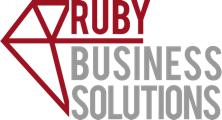Bank reconciliations, or in other words, making sure your records match your actual bank transactions are a critical aspect of your business financial health. In this guide, we’ll explore bank reconciliations, explaining what they are, why they matter, and how to perform them effectively. You’ll find out how Ruby Business Solutions can assist you in managing this essential financial task.
What Is A Bank Reconciliation?
A bank reconciliation is a fundamental financial practice. It involves comparing your company’s internal financial records with the transactions listed in your bank statement. This process serves a vital purpose: to identify and rectify any discrepancies that might exist between these two sets of financial data.
In essence, a bank reconciliation can be thought of as an important financial health check for your business. It acts as a vigilant guardian, working to make sure that your accounting records maintain the highest levels of precision.
It also offers important insights into your cash flow, reinforcing your financial integrity and your overall fiscal stability.
Why Are Bank Reconciliations Important?
Bank reconciliations are crucial for several reasons:
1. Detecting Errors: They help identify errors, whether they’re due to data entry mistakes, bank processing errors, or fraudulent activities.
2. Cash Flow Management: Bank reconciliations provide real-time information on your available cash, helping you make informed financial decisions.
3. Fraud Prevention: Regular reconciliations can uncover unauthorized transactions and potential fraud, protecting your business.
How To Do Bank Reconciliations

Performing bank reconciliations in Canada involves a series of steps tailored to your business’s unique financial circumstances. Here’s a simplified guide:
Step 1: Gather Documents
Collect your bank statement, cash receipts, and any other relevant financial records.
Step 2: Compare Bank Statement To Records
- Match each transaction on your bank statement to the corresponding entry in your financial records.
- Highlight any discrepancies or missing entries.
Step 3: Investigate Discrepancies
For any discrepancies found:
- Check for data entry errors in your financial records.
- Contact your bank to verify transactions if needed.
- Investigate any potential fraudulent activity.
Step 4: Adjust Your Records
Make adjustments in your accounting records to reflect the corrected balances and transactions.
Step 5: Reconcile The Accounts
Ensure your adjusted bank balance matches your adjusted book balance.
Step 6: Document The Process
Maintain clear and organized records of your reconciliation process, including any notes, corrections, or communication with your bank.
Bank Reconciliation Software
You can make use of advanced software solutions designed to streamline and simplify your bank reconciliation process like QuickBooks Online. These sophisticated tools not only offer user-friendly interfaces but also maximize on automation, ultimately saving you valuable time and reducing the margin for errors.
At Ruby Business Solutions, we take pride in our expertise in implementing and managing these software solutions. We aim to ensure that your bank reconciliation process is efficient and accurate. By entrusting us with this task, you can maintain financial precision, and focus on growing your business.
Common Challenges And Solutions
While doing your bank reconciliations, there are several challenges that may arise, potentially causing complications in your financial records. These challenges often include:
Missing Receipts and Documents: It’s not uncommon for crucial receipts or transaction documents to go missing. This can create uncertainty in your records.
Solution: Implement a robust record-keeping system and make sure all receipts and documents are properly organized and readily accessible. Digitization can be particularly helpful in safeguarding these essential records.
Transaction Errors: Human errors during data entry can lead to discrepancies between your records and bank statements, making reconciliation more challenging.
Solution: Double-check all data entries and make sure they’re accurate. Consider using accounting software with built-in error-checking features to minimize these errors.
Timing Differences: Transactions might not always align perfectly in timing between your records and bank statements, leading to discrepancies.
Solution: Create a clear schedule for reconciliation tasks, aligning them with your bank statement periods. This helps in identifying and addressing timing differences more effectively.
Complex Transactions: Some financial transactions can be complex and challenging to reconcile, especially in a business context.
Solution: Seek professional assistance from experts when dealing with complex transactions.
By addressing these common challenges with these solutions, you can improve efficiency and accuracy of your bank reconciliation process, making sure your business stays financially healthy.
Uncovering Embezzlement And Fraud
Bank reconciliations are not just a tool for ensuring financial accuracy; they are also a crucial defense against financial misconduct within your organization. Embezzlement and fraud can be significant threats to a business’s financial stability, and bank reconciliations play a pivotal role in detecting these illicit activities.
How Bank Reconciliations Help Detect Fraud
Anomalies in Transactions: Regular bank reconciliations help you spot unusual or unauthorized transactions that don’t align with your business operations. This can include withdrawals, transfers, or payments to unknown recipients.
Discrepancies in Balances: Discrepancies between your bank statement and your internal financial records may indicate foul play. Fraudsters may manipulate records to hide their activities, but these irregularities can be exposed through diligent reconciliation.
Unauthorized Access: Bank reconciliations can reveal instances of unauthorized personnel gaining access to your business accounts. Discrepancies in who initiated or approved transactions can raise red flags.
Pattern Recognition: Consistent reconciliation can help you identify patterns of suspicious activity over time. Frequent discrepancies or recurring irregularities should prompt further investigation.
Inconsistent Documentation: Embezzlers often rely on forging or manipulating documentation to cover their tracks. By cross-referencing your records with bank statements, you can uncover inconsistencies.
Benefits Of Outsourcing Bank Reconciliation Services
While understanding how to perform bank reconciliations is important, many businesses in Canada opt to outsource this task to professionals. Ruby Business Solutions can offer your business specialized services that come with several benefits:
Accuracy: Our experienced team ensures your bank reconciliations are error-free, giving you peace of mind.
Time-Saving: Outsourcing allows you to focus on your core business operations while we handle the financial details.
Fraud Detection: We use advanced tools and techniques to uncover any signs of fraudulent activity, protecting your assets.
Expert Advice: Gain insights and recommendations from financial experts to improve your financial management.
Don’t Hesitate To Ask For Help
If the process of bank reconciliation feels overwhelming or time-consuming, remember that you don’t have to tackle it alone. Our team of experts at Ruby Business Solutions is here to assist you every step of the way. With our specialized knowledge in bookkeeping and reconciliation services, we can streamline your financial operations, allowing you to channel your efforts into the growth and prosperity of your business.
Don’t hesitate to reach out to us for personalized assistance tailored to your specific needs. Together, we’ll secure the financial future of your business, one reconciliation at a time. Contact us today!

FAQ’s
How often should I perform bank reconciliations?
It’s recommended to perform bank reconciliations on a monthly basis at a minimum. This helps ensure that any discrepancies or issues are identified and addressed promptly. However, some businesses with high transaction volumes may choose to reconcile their accounts more frequently, such as weekly or bi-weekly, for enhanced financial control and accuracy.
Is outsourcing bank reconciliations expensive?
Not necessarily. Outsourcing can be cost-effective when you consider the time saved and the expertise gained.
What should I do if I discover a discrepancy during a bank reconciliation?
If you uncover a discrepancy during a bank reconciliation, don’t panic. First, double-check your records for errors or omissions. If the issue persists, contact your bank to verify the accuracy of their statement. If the discrepancy remains unresolved, consult with a financial professional or consider outsourcing your bank reconciliations to experts like Ruby Business Solutions for a thorough investigation and resolution. Swift action is crucial to maintain financial accuracy and integrity.







